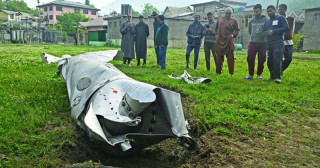
ہمارے اردگرد کئی ایسے پودے موجود ہیں جو قدرت کا تحفہ ہیں لیکن ہم اپنی کم علمی کے باعث ان سے فائدہ نہیں اٹھا پاتے ۔ان پودوں میں سے ایک سوہانجنا(انگریزی نامMoringa oleifera) ہے جو پاکستان میں سندھ اور جنوبی پنجاب کے علاقوں میں صدیوں سے موجود ہے۔آج اسے دنیا میں ایک کرشماتی پودے کی حیثیت سے جانا جاتا ہے۔ اس کے پتے، شاخیں اور جڑوں کے ساتھ ساتھ بیج میں بھی اہم غذائی اجزاء موجودہیں۔اس پودے کے کرشماتی فوائد سے دنیا اس وقت آگاہ ہوئی جب اسے سینیگال میں قحط کے دوران غذائی ضروریات کو پورا کرنے کے لیے استعمال کیا گیا۔پاکستان میں اس کے کرشماتی خواص پر تحقیقات کرنے اور عوام میںاس کی کاشت سے متعلق شعور اجاگر کرنے کا سہرا پروفیسر ڈاکٹر شہزاد بسرا کے سر ہے جو عرصہ دراز سے "مورنگا فار لائف" کے پلیٹ فارم سے لوگوں کی رہنمائی کر رہے ہیں۔ان کی تحقیق کے مطابق اس پودے کا اصل وطن جنوبی پنجاب ہے جہاں سے یہ پودا برصغیر کے دیگر حصوں اور جنوبی افریقہ میں پہنچا۔ایک وقت تھا کہ پاکستان میں اس کی 13قسمیں(سپی شیز) تھیں لیکن اب ان میں سے دو سپی شیز باقی ہیں جن میں سے دنیا بھر میں سب سے زیادہ اہمیت مورینگا اولیفیرا کو حاصل ہے۔یہ درخت ان علاقوں میں بہترین کارکردگی ظاہر کرتا ہے جہاں درجہ حرارت18سے 48 سینٹی گریڈ اورسالانہ بارش 250سے 1500ملی میٹر سالانہ ہو۔اس کی بنیادی ضروریات کو مدنظر رکھتے ہوئے سندھ اور جنوبی پنجاب کے صحرائی علاقوں میں کاشت کرنے سے کثیر زرمبادلہ کمایا جاسکتا ہے۔
دنیا بھر کے ماہرین غذائیت اور فوڈ سائنس کے ماہرین اس کی کرشماتی صفات پر حیران ہیں۔اس کے ہر حصہ کو بطور غذا استعمال کیا جاسکتا ہے۔پھول بطور سبزی پکائے جاتے ہیں، پھلیوں کا اچار اور سالن تیار کیا جاتا ہے جبکہ جڑوں کا اچار پاک و ہند میں مقبول ہے۔تحقیقات کے مطابق مورنگا میں دودھ کے مقابلے میں 17گنا زیادہ کیلشیم، دہی سے 9گنا زیادہ پروٹین، گاجر سے 4گنا زیادہ وٹامن اے ،بادام سے 12گنا زیادہ وٹامن ای،کیلے سے 15گنا زیادہ پوٹاشیم اور پالک سے 19گنا زیادہ فولاد پایا جاتا ہے۔ سوہانجنا کے پتوں کی افادیت دیکھتے ہوئے مختلف ممالک میں انھیں بطور غذا استعمال کیا جا رہا ہے اور مغربی ممالک میں اس کے ایکسٹریکٹ سے تیار کردہ کیپسول، گولیاں اور فوڈ سپلیمنٹ بنا کر فروخت کر رہے ہیں۔ جاپان کی ایک معروف دودھ کمپنی عرصہ دراز سے موریناگا Morinaga کے نام سے بچوں کا دودھ بنا رہی ہے جو مورنگا کی غذائی خصوصیات سے بھرپور ہے۔اس کے پتوں کا پچاس گرام سفوف دن بھرکی غذائی ضروریات کو پورا کرنے کے لئے کافی ہوتا ہے۔ایک غریب آدمی جو مہنگے پھلوں اور گوشت کا متحمل نہیں ہوسکتا وہ مورنگا کے استعمال سے اپنی غذائی ضروریات سستے داموں باآسانی پوری کر سکتا ہے۔ مورنگا میں دمہ، السر، جوڑوں کا درد، بے خوابی، بلڈ پریشر،مرگی ، کولیسٹرول،کینسر اور جنسی کمزوری سمیت کم و بیش تین سوبیماریوں کا علاج موجود ہے۔
مورنگا کا درخت دو سے تین سالوں میں بیج دینا شروع کر دیتا ہے۔ ایک درخت سے تقریباََ 3-4کلو بیج حاصل ہوتے ہیں اور ایک کلو بیج سے تقریباً ایک پاؤ تیل نکلتا ہے۔ اس کے بیج میں 35سے 40فیصد تیل موجود ہوتا ہے جو کوالٹی میں عمدہ اور زیتون کے برابر ہوتا ہے۔مورنگا کی کاشت کو پاکستان میں فروغ دے کر خوردنی تیل پر خرچ ہونے والے اربوں روپے بچائے جاسکتے ہیں۔دنیا میں موجود دواساز کمپنیاں، کاسمیٹک، انڈسٹریز، آئل فیکٹریز، بائیو ڈیزل پلانٹس اور بہت سی دیگر صنعتیں اس سے مستفید ہو رہی ہیں۔یہی نہیں بیج سے تیل نکالنے کے بعد اس کی کھلی کو پانی صاف کرنے کے لیے استعمال کیا جاتا ہے۔پاکستان ان ممالک میں شامل ہے جہاں صاف پانی کی عدم دستیابی کے باعث ہر سال لاکھوں لوگ بیماریوں میں مبتلا ہوتے ہیں۔ ان علاقوں میں جہاں صاف پانی کے مسائل ہیں۔ لوگوں کو اس طریقہ کار کے متعلق شعور دے کر صحت کے مسائل پر قابو پایا جاسکتا ہے۔پانی کی کمیابی کے علاوہ دنیا میں ایک اور بڑا مسئلہ کیمیائی کیڑے مار ادویات کے استعمال سے پیدا ہونے والے ماحولیاتی مسائل ہیں۔یہی وجہ ہے کہ دنیا تیزی سے حیاتیاتی کیڑے مار ادویات کی طرف منتقل ہورہی ہے جس میں مورنگا کو خاص مقام حاصل ہے۔اس کے پتے کو نچوڑ کر رس کو سپرے کیا جائے تو
پودوں میں بیماریوں کے خلاف مدافعت پیدا ہوتی ہے اور بغیر کسی اضافی خرچہ کے40فیصد تک پیداوار میں اضافہ کیاجاسکتا ہے۔
مورنگا کو تجارتی مقاصد کے لیے دنیا بھر میں کاشت کیا جار ہا ہے۔یہ پودا ایک سال میں 10سے 15فٹ کا درخت بن جاتا ہے۔اس پر سال میں ایک دفعہ پھول آتے ہیں جو بعد میں پک کر پھلیوں کی شکل اختیار کرلیتے ہیں۔ ایک درخت کی پھلیوں سے آٹھ سے دس ہزار بیج حاصل ہوسکتے ہیں جن سے سوہانجنا کو فصل کے طور پر بھی کاشت کیا جاسکتا ہے۔ بیج کو کپاس اور مکئی کی بجائی کی طرح 1فٹ کے فاصلے پر لگایا جاتا ہے۔ جب یہ پودے تین فٹ پر پہنچ جائیں تو ان کو اوپر سے کاٹ دیا جاتا ہے پھر بار بار 10سے 20دن کے وقفہ سے اس کے پتے بطور چارہ کاٹ کر استعمال کئے جا سکتے ہیں۔مویشیوں کے لیے مورنگا کے پتے بطور چارہ استعمال کرنے سے مہنگے کھل اور بنولہ استعمال کرنے کی ضرورت نہیں رہتی ۔تحقیق کے مطابق مورنگا کے پتوں کا استعمال مویشیوں کے وزن میں 32فیصد اور دودھ میں 65فیصد تک اضافہ کا باعث ہے۔چارے کے لیے اس درخت کو سال میں 12سے 16دفعہ تک کاٹا جاسکتا ہے اور اس کا سیڈ کیک بھی بطور چارہ استعمال کیا جاسکتا ہے۔
مورنگا کی کاشت کے لیے دوسرا مقبول طریقہ بذریعہ قلم ہے جس میں 4سے 5 فٹ کی شاخ منتخب کر کے ایک فٹ چوڑااور 3فٹ گہرا گڑھا کھود کر دبا دیا جاتا ہے۔گڑھے بھرنے کے لیے ریت ، بھل اور پتوں کی کھاد کا آمیزہ استعمال کیا جاتا ہے اور کوشش کی جاتی ہے کہ پانی براہ راست قلم کو نہ لگے بلکہ صرف نمی پہنچے۔یاد رہے کہ گڑھوں کا درمیانی فاصلہ 10سے 15فٹ تک ہونا چاہیے اور قلم کا 1/3حصہ زمین کے اندر ہو۔ جب بیج اور قلم کے ذریعہ مورنگا کی کاشت ممکن نہ ہو تو نرسری کا طریقہ استعمال کیا جاتا ہے جس میں پلاسٹک کی تھیلیوں میں مٹی، ریت ، بھل اور قدرتی کھاد کے آمیزہ سے بھر کر ہر تھیلی میں دو سے تین بیج لگادئیے جاتے ہیں۔ایک ہفتہ میں بیج کا اگائو مکمل ہوجاتا ہے اور ڈیڑھ ماہ بعد پودے کھیت میں منتقل کرنے کے قابل ہوجاتے ہیں۔کھیت میں منتقلی کے فوراً بعد پانی لگایا جاتا ہے اور کچھ عرصہ تک ہفتہ وار آبپاشی کی جاتی ہے ۔چونکہ مورنگا گرم اور خشک آب و ہوا کا پودا ہے اس لیے کم پانی میں بھی گزارا کر سکتا ہے، اگر پانی دستیاب ہو تو دو ماہ بعد ہلکی آبپاشی مفید ثابت ہوتی ہے ۔ چارہ کے حصول کے لیے ایک ایکڑ مورنگامیں دو بوری یوریا کھاد ڈالنے سے بہتر نتائج حاصل ہوتے ہیں۔ جڑی بوٹیوں کو کنٹرول کرنے کے لیے بجائی کے 24گھنٹے کے اندر اندر بوٹی مار سپرے کرنا چاہیے ۔یوں تو مورنگا کیڑے مکوڑوں کے خلاف قوت مدافعت رکھتا ہے لیکن جڑوں پر دیمک کے حملہ سے اس کے سوکھنے کا خدشہ رہتا ہے جس سے بچائو کے لیے سفارش کردہ زہر استعمال کیا جاسکتا ہے۔
مورنگا کو کسان اپنے کھیتوں کے آس پاس بھی اگا سکتے ہیں کیوں کہ اس کی جڑیں گہری ہوتی ہیں اس لیے یہ زمین کی زرخیزی کو نقصان نہیں پہنچاتیں بلکہ اس کے پتے زمین پر گر کر زرخیزی میں اضافہ کرتے ہیں۔مغربی ممالک میں مورنگا کی کچن گارڈننگ کی جارہی ہے اور اس کے مختلف حصوں کو روز مرہ خوراک میں استعمال کیا جاتا ہے۔اس کے کرشماتی خواص کے باعث ہم اسے اپنے گھروں میں،سڑکو ں کے کنارے اور پارکوں میں بھی لگا سکتے ہیں۔مورنگا کی وسیع پیمانے پر کاشت کے لیے حکومت کو مختلف پراجیکٹس متعارف کرانے ہوں گے اور کاشتکاروں میں شعور اجاگر کرنا ہوگا تاکہ زرعی ترقی
کے علاوہ کثیر زر مبادلہ بھی کمایا جاسکے۔
https://jang.com.pk/news/491316
Last edited by a moderator:








































